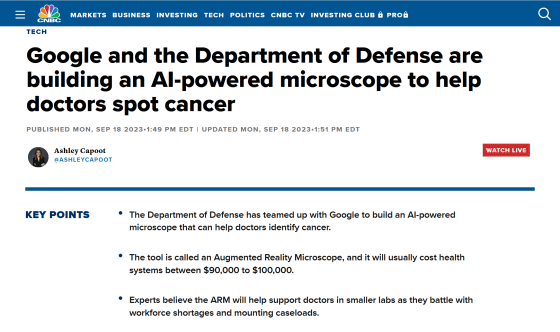Google and the US Department of Defense are developing an ``AR microscope'' that uses AI to discover cancer in patients

Overseas media outlet CNBC reported on the Augmented Reality Microscope (AR microscope), which is being jointly developed by Google and
Google, DoD built an AI-powered microscope to help doctors spot cancer
https://www.cnbc.com/2023/09/18/google-dod-built-an-ai-powered-microscope-to-help-doctors-spot-cancer.html

Pathologists diagnose whether or not a patient is affected by cancer based on samples taken from the patient, but this diagnosis comes with a great responsibility. Dr. Niels Olson, chief medical officer of the Defense Innovation Unit, an organization under the Department of Defense, was previously dispatched to Guam as a U.S. Navy surgeon and was the only pathologist at a naval hospital. He was given various diagnoses.
'It's not a pathologist's job to just say, 'This is cancer. This is this type of cancer,'' Olson said in an interview with CNBC. 'Part of the job is to say, 'This is definitely not cancer. '', which makes it stressful to work alone,'' he says, explaining that pathologists are under a lot of pressure as they make diagnoses that affect the life and death of patients.
Mr. Olson came up with the rough idea of ``AR microscope'' while working at the Naval Medical Center in San Diego in 2016 before being dispatched to Guam. I discussed this idea with an acquaintance at Google, and a few months later I was invited to Google's office building in Mountain View, California, to demonstrate an early ``AI-equipped microscope'' in a closed room that only a few people had access to. It seems like it is.
This AI-equipped microscope was able to accurately detect cancer from the slide set that Mr. Olson brought, so Mr. Olson and his colleagues were very excited. 'I don't want to say it was like when I saw my child, but I felt like this was something amazing and could be done,' Olson told CNBC.

Mr. Olson was then dispatched to Guam, but the Defense Innovation Unit took over the AI-equipped microscope project, and selected Google and optical company
In a 2019 article published by Olson et al. about AI-powered microscopes, the U.S. federal health care system enrolls millions of patients, making it the 'world's most comprehensive medical data set.' It is written. He also said, ``Big data is what Silicon Valley is best at, and the potential for it to spill over into private healthcare systems is enormous.''
A team from Google and the US Department of Defense has already succeeded in developing an AR microscope, and although it is not yet actively used for patient diagnosis, 13 AR microscopes have been deployed at related facilities. The image below is an AR microscope deployed at Miter , a non-profit organization that works with government agencies to address technology-related issues. An AR microscope looks like an optical microscope in a school science lab, with a large eyepiece and a tray for holding glass slides, but it also has a box-shaped computer tower that houses the AI model. is also connected.

When the slide glass is fixed to the microscope, the AI will display a green frame showing where the cancer is located by superimposing it on the image from the eyepiece, and will also generate a heat map that pixelates the boundaries of the cancer.

In recent years, attempts have been made to digitize the work of pathologists, but digitizing a single slide requires more than 1GB of data. As a result, diagnosing large numbers of patients increases infrastructure costs and makes digitalization a burden for many small healthcare organizations.
On that point, an AR microscope that integrates the system with a conventional optical microscope can reduce the burden on medical institutions to $90,000 to $100,000 (approximately 13.3 million yen to 14.8 million yen). Patrick Minott, an autonomous systems engineer at Miter, said physical microscopes are essential to a pathologist's diagnostic process and joked that many people had warned him to leave the microscope alone. Told.
Google has already developed four algorithms to identify breast cancer, cervical cancer, prostate cancer, and mitosis , said Aasima Gupta, global director of healthcare strategy and solutions at Google Cloud. About. The AI model is trained on the Defense Innovation Unit's dataset, and encryption makes the original data inaccessible, Gupta explains.
In the fall of 2022, the research team published a paper in the peer-reviewed journal Journal of Pathology Informatics, reporting that the breast cancer AI algorithm worked well in the majority of samples. There is still a huge amount of testing required before AR microscopes will actually support pathologists in the real world, but the Defense Innovation Unit is already working with Google and Jenoptik to distribute AR microscopes through military and commercial channels. It is said that contract negotiations have begun.
Dr. Nadeem Zafar, a pathologist at Seattle's Veterans Affairs Hospital, said he used an AR microscope to analyze samples when he and a colleague disagreed over how serious a patient's prostate cancer was. About. As a result, the patient's prostate cancer was found to be highly aggressive, as Zafar had predicted. His fellow doctors were also satisfied with the results of the AR microscope, and Zafar commented to CNBC, ``This is the beauty of this technology, and it becomes a kind of arbiter.''
Related Posts:







